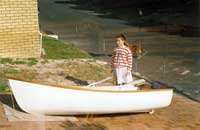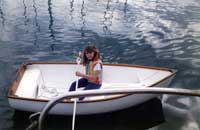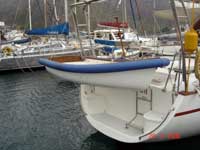| Well
once upon a time, anyone requiring a tender to his
or her yacht, the so called ‘Hard Dinghy’,
was all that we could look at, often a class boat
‘pressed into service’ and used as the
tender, fitted with an outboard, it may never have
sailed again?
Then we saw the start of the so called ‘Rubber
Ducks’, probably due to a British company called
‘Avon’, producing their smallest offering
and naming it the ‘Redcrest’, a sort of
Duck. This was the mid sixties and the trend from
then on was for rubber boats and eventually those
with hard bottoms, either in plywood or GRP moulded
with the float tubes really just keeping the water
out. Normally a power propelled craft, as rubber boats
do not row well at all.
As we moved ever closer to the twenty first century
and the year 2000,we started to see fewer and fewer
hard dinghies being offered for sale, such was the
trend to the still called ‘Rubber Ducks’
a name that has stuck for a very long time now.
Back in 1946 ‘Fairy Marine’ in England,
produced a sailing tender, cold moulded in laminated
wood veneers, and popped out as a pressed shell in
some quantity, they sail well, as any design by the
late Uffa Fox always will…….They are still
about and still sailing too.
|  A
locally produced Duckling Dinghy, note the flare
of the bow and the craft's width carried aft.
This boat has no connection with the boats built
by Fairy Marine, this GRP boat is very much
more a modern style, nice to look at from any
angle, which is not the case with Uffa Foxes
design. A
locally produced Duckling Dinghy, note the flare
of the bow and the craft's width carried aft.
This boat has no connection with the boats built
by Fairy Marine, this GRP boat is very much
more a modern style, nice to look at from any
angle, which is not the case with Uffa Foxes
design.
|
Here in South Africa, we have another ‘Duckling’
as well, it was moulded in GRP in Cape Town by MSM
and I was told that the mould or ‘Plug’
for the boat was made by George Meek, a very well
known yachting and climbing person from Cape Town.
When our own Duckling is repainted from time to time,
it’s still possible to just see the moulding
marks from the strips of plywood that George will
have used? One local yachtsman actually commented
at how nice our ‘wooden’ dinghy looked.
There are hard dinghies still being moulded but very
few these days, lots were made in False Bay by a certain
Jonathan Reid, he was popping them out each week to
order, around twenty years back, all from a mould
he had been given. The dinghy never had a class name
that I know about. Either way, they are very unstable
and not to be recommended, as you have to step exactly
into the boats center when boarding if your are not
to tip the boat over.
 |
A newly restored
twenty five year old Duckling. Janet can row
it with ease. |
Should you be in the market for a new dinghy, there
is another hard dingy being advertised nationally
but its quite an expensive option. I assume its an
import, but for those who do not mind using a little
hard work, preparation, plus a little searching around,
add a bit of luck too, you will find many MSM Ducklings,
lying around in the various yacht and boat clubs in
South Africa. I doubt their purchase will be at all
expensive.
When we first tried to sail our Duckling it was a
dismal failure. The Seagull outboard normally had
to push us back to where we had started, so sailing
was not much tried.
Then I had a look at its original and very old sail,
very light cloth and more a bag than a sail. Taking
the sail to Geoff Meek, Georges son, at North Sails,
saw a brand new sail being produced by them, while
I made new hollow wooden spar set from clear Oregon
Pine. With both of these new items the boat was very
much a better sailer but still not exactly sparkling
up wind. This was to change when we took Janet, then
aged thirteen, to the Imperial YC to do an overnight
camp and sailing instruction course (recommended).
Ours was the only Duckling and I was surprised to
see that all the Optimists sailing had such long dagger
boards, our Duckling had the original MSM supplied
item and at least 600mm shorter than those on an Optimist.
It took some persuasion but on borrowing an Optimist
dagger board for a trial sail, I returned back to
my starting point with great ease, problem solved!
Our Duckling came our way in a swap, some cash and
an exchange for the dinghy, Seagull outboard and some
sets of wet weather gear too. It was a good deal,
as even twenty five years on we still have all but
the Seagull. That was exchanged for an Inflatable
boat when we arrived in Rio De Janeiro, with an outboard
but no boat but that’s another story.
Our Duckling is well traveled. Its been to Brazil,
The West Indies, Venezuela and all the way back again
on the deck of our last yacht, ’Ocean Cloud’,
an Endurance 37, by Peter Ibold. The dinghy is light
enough for two to drag it up a beach, easy to lift
onto your boat with a spare halyard and will carry
four persons with safety and ease. It came with what
I suspect was a factory option, a 100mm diameter nylon
wheel fitted in the small keel under the transom.It’s
a very neat piece of work and easily allows just one
person to roll the boat up or down a slip or hard
surfaced area.
It’s a safe tender due to its fore and aft
enclosures, and while you can flood it, you should
not be able to sink it. It will row and sail, all
it needs is a 2hp outboard and it will speed along
with a full load at a low throttle opening and top
speed. It’s also very stable due to its extra
width at its stern.
|  The
final development chapter on our Ducking came
two years back when after another paint and
restoration job, I fitted the two 130mm diameter
inflatable floats on both sides. The reason
for this was two fold. At a stroke we had a
very unsinkable tender, plus coming along side
a boat, we had a built in form of fender as
well. The
final development chapter on our Ducking came
two years back when after another paint and
restoration job, I fitted the two 130mm diameter
inflatable floats on both sides. The reason
for this was two fold. At a stroke we had a
very unsinkable tender, plus coming along side
a boat, we had a built in form of fender as
well.
|
Yours in a Duckling,
Regards
Roy Mc Bride
https://www.ckdboats.com/

|